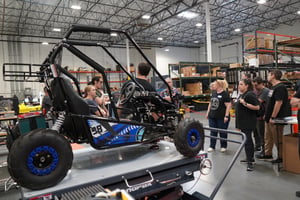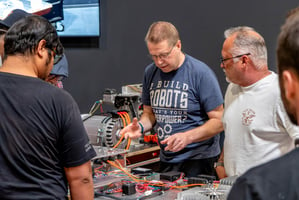Maricopa County Superintendent Steve Watson and Legacy EV, have joined forces to create the EV...
Plugged In: Understanding DC Fast Charging with CCS and NACS
As the electric vehicle market evolves, DC fast charging is becoming a core component of modern EV technology. For technical educators, it’s essential to understand how these high-power systems operate, how they differ from Level 1 and Level 2 charging, and how to prepare students to work safely and effectively with them.
Revisiting the Basics: AC Charging Standards
Before diving into DC fast charging, it’s important to have a clear understanding of how AC charging works, since it remains the foundation for most EV service work and training programs.
Type 1 (J1772) is the standard AC connector used across North America for both Level 1 and Level 2 charging. It’s commonly found in residential, commercial, and educational settings, and is widely used across most production EVs. In a Level 2 application, J1772 can deliver up to 19.2 kW, depending on the vehicle’s onboard charger and the circuit supplying power.
Type 2 (Mennekes) is the standard AC connector in Europe and supports both single-phase and three-phase AC charging. While not widely used in North America, it may be encountered when working with imported vehicles or global platforms.
Charging Speed and Battery Size
Charging speed is determined by power output, measured in kilowatts (kW) which is the product of voltage (V) and current (A). Higher voltage and current allow for faster energy transfer, but actual charge rate also depends on the vehicle’s onboard systems and battery size.
For example, an EV operating at 400V and drawing 125A will charge at around 50 kW (400V × 125A = 50,000W).
A larger battery doesn't necessarily charge faster. It simply takes longer to fill, like a larger fuel tank. Here's how battery size influences charge time:
| Battery Size | Level 2 @ 19.2 kW | 50 kW DC Charger | 150 kW DC Charger |
| 40 kWh | ~ 2 hours | ~ 50 minutes | ~ 20 minutes |
| 80 kWh | ~ 4.5 hours | ~ 90 minutes | ~ 35 minutes |
| 120 kWh | ~ 6.5 hours | ~ 2+ hours | ~ 45 minutes |
Note: Fast charging speed tapers as the battery nears full capacity to protect battery health. Most sessions target \~80% SOC.
What Makes DC Fast Charging Different?
Unlike Level 1 and Level 2 charging, DC fast charging bypasses the onboard charger. The conversion from AC to DC occurs in the charging station, allowing direct delivery of high-voltage DC to the vehicle’s battery.
To support DC charging, a vehicle must include:
- High-voltage battery system, typically 200V or higher
- DC-compatible charge port, such as CCS or NACS
- Charge management system to communicate with the charger and battery management system (BMS)
DC power flows through a dedicated high-voltage charge path, separate from the traction and AC charging systems. In production EVs, this path is typically integrated into a Power Distribution Unit (PDU) a centralized module housing the vehicle’s contactors, fuses, sensors, and precharge circuitry.
Understanding this architecture helps students and technicians grasp how charging behavior, diagnostics, and safety systems all connect.
CCS: Separate Paths for AC and DC
The Combined Charging System (CCS) supports both AC and DC charging through a single connector. In North America, CCS1 builds on the J1772 plug by adding two large DC pins. These pins are only active during fast charging, bypassing the onboard AC charger.
In a CCS system, DC power flows through a dedicated high-voltage circuit, typically routed through the PDU and electrically isolated from the drive system when inactive.
A CCS-enabled EV includes:
- Dedicated DC contactors (positive and negative)
- Charge control ECU (managing CP/PP signaling and charge state)
- CAN communication with the BMS for current, voltage, and thermal data
- Precharge circuit to limit inrush current
- High-voltage interlock loop (HVIL) for fault detection
CCS supports charging rates up to 350 kW and is the most common standard on public networks such as Electrify America and EVgo. Its physical separation of AC and DC paths makes it well-suited for instructional use in system isolation and EVSE communication protocols.
NACS: Shared Pins, Smarter Switching
The North American Charging Standard (NACS) delivers AC and DC charging using the same pair of high-voltage pins, relying on intelligent switching and control logic. Developed by Tesla and rapidly adopted across the industry, NACS offers a compact alternative to CCS.
Though AC and DC share conductors, power is still routed through a dedicated high-voltage charge path within the PDU, isolated and controlled based on the type of EVSE connection.
Core components of a NACS system include:
- NACS port and latch controller to manage plug status and safety
- Dual-use HV contactors shared across AC and DC modes
- CAN-connected BMS and ECU for mode detection, fault response, and energy management
- Voltage sensing and insulation monitoring on the DC line
Safety requirements are especially stringent due to shared conductors:
- DC contactors are blocked if AC voltage is detected
- AC charging is disabled when the DC path is energized
- Latch and plug status are monitored continuously before energization
- The system meets ASIL-D safety standards through redundancy and real-time validation
NACS currently supports up to 250 kW, with future expansion planned to 1 MW. Its shared-pin design makes it a leading example of compact system integration and software-managed power routing.
System Design and Instructional Considerations
Adding DC fast charging to a vehicle design involves more than just a port and a battery. It requires deep integration of high-voltage components and real-time communication systems.
Key elements include:
- High-voltage battery (typically 350–800V)
- Charge control module to manage handshake and regulate power delivery
- Contactors, fuses, precharge circuits, and interlocks for safety and control
- CAN-based communication with the BMS for state-of-charge and thermal management
Practical limitations:
- DC fast chargers are expensive, often ranging from \$10,000 to over \$100,000
- System integration is complex, requiring coordination across hardware and software
- Standard compatibility (CCS vs. NACS) is still evolving, with both requiring different charge management solutions
Even if your lab doesn’t implement DC fast charging hardware, understanding how these systems are designed and controlled prepares students for real-world EV careers in diagnostics, engineering, and system integration.
Ready to Dive Deeper?
To dive deeper into EV systems and bring hands-on learning to your program, check out our full lineup of EV curriculum and lab packages. Whether you’re teaching fundamentals or advanced diagnostics, we’ve built resources to support educators at every level.
Subscribe to the EV Educator newsletter for more insights, teaching tools, and real-world EV knowledge delivered straight to your inbox. Let’s build the next generation of EV technicians—together.

.png?width=779&height=176&name=Legacy-logo-dark%20(no%20extension).png)


